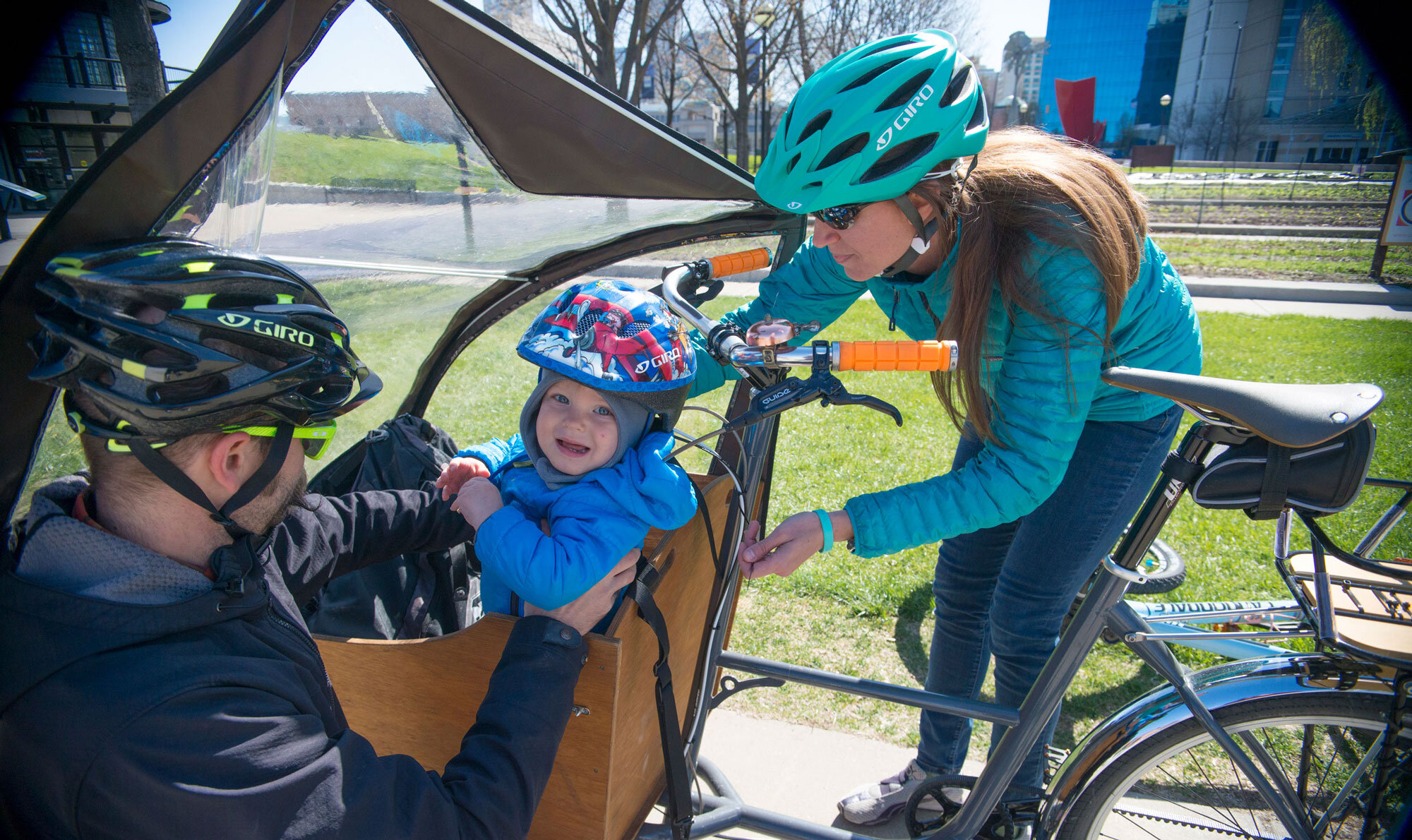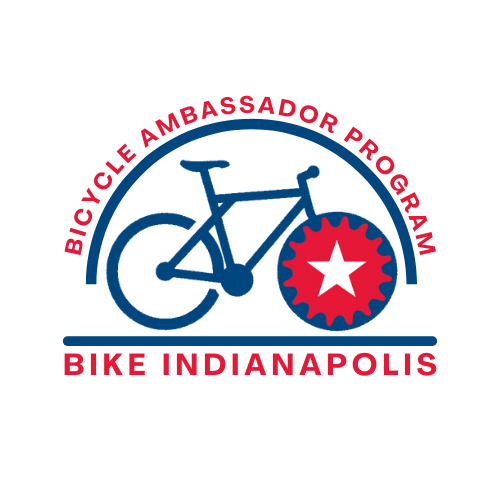
Educate
A concern for personal safety is high on any list of reasons why adults don’t ride bicycles. Most bike riders learned to ride by having a parent, sibling, or other relative run along behind them until they had enough speed to stay up, and then they were riding. The training didn’t extend to how to ride on city streets with motor vehicles. As a result, riders avoid doing it or they do it in ways that seem safe but actually create potential conflicts with motorists. Bike Indianapolis is changing that by bringing nationally recognized bicycle safety training to central Indiana. We are partnering with the League of American Bicyclists and the American Bicycle Education Association to provide meaningful bicycle safety training in central Indiana. We hope to do this thru development of a permanent bicycle safety course, but will start using makeshift courses in the area.
Unsurprisingly, those who “grew out of bicycling” when they became motorists had no more training on riding in the street or on sharing the street with bicycle riders. For these drivers, Bike Indianapolis is partnering with Bicycle Garage Indianapolis, Bicycle Indiana, and Bike Fort Collins to provide Bicycle Friendly Driver training in Indianapolis.
Bicycle Ambassador Program
Can I ride my e-bike on the Monon? If there is a multi-use trail, does that mean I can’t ride on the street? Are bike lanes only one way? How do I signal to turn? These are some of the questions we can answer through our Safe Cycling Education Program. Do you have an organization, business or group that would like to learn more about cycling in Indianapolis? The Bicycle Ambassador program was created to offer you a chance to learn all about safe cycling and encourage more people to get out and ride, in a safe and confident manner.
Topics include:
Bicycle Friendly Driver
Road Safety Training
Bicycle Commuting
Topics can be tailored to your specific interests & needs.
If you are interested in this opportunity, please send an email to info@bikeindianapolis.org.
Are you an expert cyclist and would like to share your knowledge? Become a Bike Ambassador! Let us know by filling out our volunteer form.
FREE EDUCATIONAL OPPORTUNITY
Many of us grew up riding bikes but for some, that has become a hazy memory. Bike Indianapolis wants to help you remember the joys of riding, provide you with tips to keep safe while you ride and, as drivers, how we can keep cyclists safe on our streets. This 1.5 hour educational seminar will provide information on the many benefits of riding, how to ride safely and how we can safely share the road with cyclists.
Registrants will be provided with a front and tail bike light as part of their participation. Registration is required. Please note that this is a classroom presentation. There is no bike ride attached to this event.
Want to learn more? Here is some of the content we will provide during our educational trainings. By educating the community on these problems, we hope to decrease the number of bicyclists involved crashes:
There are four concepts that lead to a high rate of crashes involving bicyclists in Indianapolis. The four focus areas are:
1. Ride on the Road
While riding on the sidewalk is NOT illegal, there are numerous reasons why it is safer to ride in the street.Motorists at intersections are not expecting fast-moving traffic on the sidewalk. Add to that things like parked cars, trees, signage, and other visual clutter, and it is too easy for a driver to miss seeing a cyclist riding on the sidewalk. All this puts cyclists at risk at intersections and driveways.
Another aspect of this is that riding on the sidewalk encourages motorists to consider us pedestrians instead of vehicles, and makes them resent sharing “their” road with us. The more bikes they encounter, the more bikes and cars will learn to coexist on the roads.
2. Ride with Traffic
People often mix up pedestrian and cyclist rules. According to Indiana law, bicyclists are considered to be vehicles — cars do not drive on the wrong side of the road, so neither should bicyclists. Riding against traffic poses a much more dangerous situation if a cyclist were to get into a crash with a car: greater closing speed, and of course, a head-on collision. Motorists approaching wrong-way cyclists head-on often cannot react in time to avoid a collision.
Yes, if you are a pedestrian it is best practice to walk so you are facing traffic. This helps keep pedestrians aware of oncoming traffic. But again: bicyclists are vehicles, not pedestrians!
3. Obey Traffic Signs & Signals
Being predictable is an important factor in staying safe on the road. This is especially important at intersections. The best way to improve cycling safety is to communicate with motorists and act in a predictable manner. In our city, bicycles are considered vehicles, and as such we are bound by traffic laws. Stop for stop signs, and obey traffic signals.
4. Ride with Lights at Night
Being seen is crucial to being safe. Motorists, pedestrians and other cyclists need to be aware of your presence in time to avoid a collision. Lights are crucial to making you visible to others on the road.
According to Indiana State Law, when operated at night a bicycle must be equipped with “a lamp on the front exhibiting a white light visible from a distance of at least five hundred feet to the front” and “a lamp on the rear exhibiting a red light visible from a distance of five hundred feet to the rear, or a red reflector.”
While front and rear lights are the only legal lighting requirements, we encourage all cyclists to be extremely conspicuous. Please wear visible colors, and deck out your bike and helmet with reflective stickers to ensure optimal conspicuity while riding at night. As part of our grant funding, Bike Indianapolis has bright, reflective stickers in a variety of sizes that are FREE to cyclists.
And, lights aren’t just a nighttime thing. Cars have daytime running lights because studies have shown that they increase conspicuity and decrease accidents. The same applies to bikes, and Bike Indianapolis strongly encourages you to use your lights any time you’re on the road!
Bicycle Friendly Driver Training
Concern for personal safety is high on any list of reasons why adults don’t ride bicycles. Fear of motorists keeps potential riders from getting started. Research shows that in most motor vehicle crashes involving bicycles, the motorist is the cause about half of the time, and both the driver and the rider could have done something to avoid or lessen the severity of the crash. Almost all bicycle training is targeted at bike riders. The Bicycle Friendly Driver program is focused on the other half of the equation.
Adding motorist training to the mix allows more people to obtain bicycle safety training. This 90 minute educational experience gives drivers who are not bicyclists a chance to see what it’s like to share the road with motor vehicles. Drivers who successfully complete the course will be given stickers designating them as Bicycle Friendly Drivers. As more drivers complete this course, new riders will feel more confident about their safety. The impact of this program will touch our entire community, from potential new bike riders to necessity bike riders to choice riders.
This program focuses on people who drive as a part of their job. They spend more time on the road, and are more visible as an indication of safety. As it expands, the course will be offered for other employers to provide to their workers. Ultimately, we hope to get this material included in Driver Education programs so new drivers will learn to share the road before they even get on the road.


